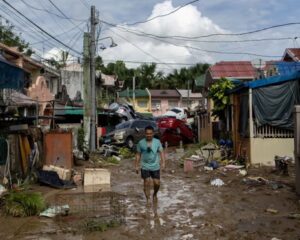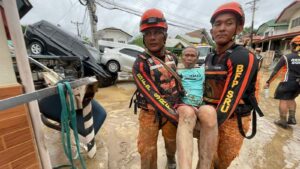The Republic of the Philippines, an archipelago habitually braced for climatic extremes, is currently grappling with the devastating aftermath of Typhoon Kalmaegi, a powerful storm that has tragically claimed at least 114 lives and left over 120 people missing across the central provinces. In response to what has become the deadliest natural disaster to strike the nation this year, President Ferdinand Marcos Jr. has formally declared a “state of national calamity,” signaling the gravity of the crisis and initiating immediate, sweeping governmental action.

The Scale of the Disaster and Immediate Impact
Kalmaegi, which traversed the Philippine landmass before exiting into the South China Sea, unleashed a torrent of destructive power, primarily through unrelenting, localized rainfall. The majority of fatalities were reported as a result of flash floods—a deadly consequence of the typhoon’s intensity, overwhelming the region’s existing drainage and river systems. The central province of Cebu bore the brunt of this calamity, accounting for the highest numbers of casualties and missing persons. Officials from the Office of Civil Defence confirmed the dire statistics, highlighting that 71 people perished in Cebu alone, with 65 missing and 69 injured, illustrating a community utterly submerged and caught off guard by the speed and volume of the rising waters. Another 62 individuals were also reported missing in the neighboring province of Negros Occidental.
The typhoon’s brutal passage has significantly disrupted the lives of nearly two million people. Mass displacement became an unavoidable necessity, with over 560,000 villagers forced to leave their homes. Emergency response facilities are currently housing close to 450,000 evacuees, underscoring a massive humanitarian operation underway to provide shelter, food, and medical assistance to those who lost everything to the relentless floods. The scenes described by provincial officials were harrowing: residents were compelled to scramble onto rooftops, desperately seeking rescue as the floodwaters rapidly engulfed residential areas, turning communities into volatile, debris-laden lakes.
Presidential Response and the Calamity Declaration
President Marcos’s declaration of a “state of national calamity” was swiftly issued following a crucial Thursday meeting with top disaster-response officials to assess the full scope of Kalmaegi’s destruction. This executive action is not merely symbolic; it provides the administration with critical operational and financial agility.
Crucially, the declaration will:
Expedite the disbursement of emergency funds: This allows for rapid channeling of necessary financial resources to the most affected local government units (LGUs) for relief and recovery efforts without the bureaucratic delays typical of normal operating procedures.
Prevent economic exploitation: The measure includes provisions to curb predatory practices such as food hoarding and price overpricing of basic necessities and construction materials, protecting vulnerable communities from further economic strain during the recovery phase.
This centralized, decisive response is vital, especially given the Philippines’ perennial struggle to manage and fund its extensive disaster preparedness and recovery efforts efficiently. The scale of the immediate need demands an unburdened and immediate flow of resources.
Intertwined Crises: Natural Fury Meets Infrastructural Flaw
The devastation caused by Kalmaegi is a stark reminder of the Philippines’ geographical vulnerability, but it also raises troubling questions about infrastructural resilience and governmental accountability.
Cebu Governor Pamela Baricuatro pointed toward deeper, human-made issues that exacerbated the natural disaster. While acknowledging the unpredictable nature of flash floods, she suggested that the impact was likely worsened by:
-
Years of Uncontrolled Quarrying: This activity often disrupts natural geological structures and causes the clogging of nearby rivers, severely reducing their capacity to handle heavy rainfall runoff. When a major typhoon hits, these clogged waterways quickly overflow, turning minor flooding into catastrophic deluges.
Substandard Flood Control Projects: The governor’s statement implicitly connects the local tragedy to a wider national issue. This disaster unfolded against the backdrop of an ongoing corruption scandal involving allegations of substandard or outright non-existent flood control projects across the country. The public outrage over the misuse of infrastructure funds has recently led to significant street protests, creating a profound crisis of confidence in government spending and project oversight.
This confluence of natural extreme and systemic failure suggests that while the typhoon delivered the immediate blow, the scale of the resulting deaths and destruction was amplified by years of inadequate planning and alleged corruption.
Furthermore, the region was already reeling from a separate, massive geological event—a 6.9 magnitude earthquake that struck on September 30. The quake killed at least 79 people and displaced thousands as buildings collapsed or were severely damaged. The psychological and physical toll on communities attempting to recover from one major catastrophe only to be struck by another highlights a layered, complex crisis for disaster management officials.
Secondary Impacts and Future Threats

The wider operational impacts of Kalmaegi extended beyond the flooded central provinces:
Transportation Paralysis: The Philippine Coast Guard enforced strict restrictions on sea travel, prohibiting ferries and fishing boats from venturing out onto the increasingly rough seas. This action stranded more than 3,500 passengers and cargo truck drivers in nearly 100 seaports, severely disrupting domestic logistics and travel.
Air Travel Disruption: Domestically, at least 186 flights were canceled, illustrating the widespread disruption to commerce and mobility across the islands.
Tragic Aid Mission: The human cost extended even to those attempting to help. Officials attributed the deaths of six personnel to the typhoon after a Philippine air force helicopter crashed in Agusan del Sur. The crew was en route to provide humanitarian assistance to the ravaged provinces, underscoring the extreme dangers faced by first responders. The military has yet to confirm the cause of the crash, but the harsh weather conditions are the presumed factor.
Alarmingly, the respite is expected to be short-lived. Disaster-response officials have issued a grim warning: another powerful tropical cyclone forming in the Pacific is projected to rapidly strengthen, potentially becoming a super typhoon that could batter the northern Philippines early next week.
The Philippines’ inescapable reality is its position as one of the world’s most disaster-prone countries, facing an annual average of about 20 typhoons and storms, compounded by its location on the volatile Pacific “Ring of Fire,” which exposes it to frequent earthquakes and active volcanoes. The tragedy of Kalmaegi, therefore, is not an isolated event but a catastrophic chapter in an ongoing, complex narrative of survival, resilience, and the urgent need for robust, corruption-free infrastructure and comprehensive disaster preparedness. The nation now faces the immense task of immediate relief while bracing for the next imminent threat.



